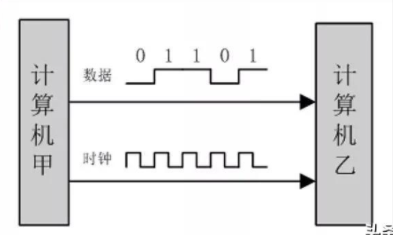Synchronous serial communication: During synchronous communication, direct control of the sender’s clock to the receiver’s clock must be established so that both parties can achieve complete synchronization;

Characteristics of asynchronous communication: It does not require strict consistency of the clocks of both the sending and receiving parties, it is easy to implement, and the equipment overhead is small. However, each character requires 2 to 3 additional bits for start and stop bits , and there are gaps between each frame, so the transmission efficiency is low. high.
The characteristics of synchronous communication: the specific bit combination “01111110” is used as the start and end marks of the frame, and the transmitted data of a frame can be any bit. Therefore, the transmission efficiency is high, but the hardware equipment implemented is more complicated than asynchronous communication.
The difference between synchronous communication and asynchronous communication:
1. Synchronous communication requires that the clock frequency of the receiving end is consistent with the clock frequency of the sending end, and the sending end sends a continuous bit stream; asynchronous communication does not require synchronization of the receiving end clock and the sending end clock . After the sending end sends a byte, it can pass through any long time interval before sending the next byte.
2. Synchronous communication has high efficiency; asynchronous communication has low efficiency.
3. Synchronous communication is more complicated, and the allowable error of the clocks of both parties is small; asynchronous communication is simple, and a certain error of the clocks of both parties is allowed.
4. Synchronous communication can be used for point-to-multipoint; asynchronous communication is only suitable for point-to-point.
Asynchronous communication principles
Asynchronous communication is a very common communication method. When sending characters in asynchronous communication, the time interval between the characters sent can be arbitrary. Of course, the receiving end must always be ready to receive. The sending end can start sending characters at any time , so it must add flags at the beginning and end of each character, that is, add a start bit and a stop bit, so that the receiving end can correctly receive each character. The advantage of asynchronous communication is that the communication equipment is simple and cheap, but the transmission efficiency is low (because the start bit and stop bit overhead account for a large proportion).
Synchronous communication principle
Synchronous communication is a communication method that continuously transmits data serially. Only one frame of information is transmitted at a time. The information frame here is different from the character frame in asynchronous communication, and usually contains several data characters.
When using synchronous communication, many characters are composed into an information group, so that the characters can be transmitted one after another. However, a synchronization character is added at the beginning of each group of information (usually called a frame). When there is no information to be transmitted, Blank characters should be filled in because synchronous transmission does not allow gaps. During synchronous transmission, one character can correspond to 5 to 8 bits. Of course, for the same transmission process, all characters correspond to the same number of digits, such as n bits. In this way, during transmission, every n bits are divided into a time slice. The sending end sends one character in one time slice, and the receiving end receives one character in one time slice.
During synchronous transmission, an information frame contains many characters. Each information frame starts with a synchronization character. Generally, the synchronization character and the null character use the same code. Throughout the system, a unified clock controls the transmission of the sender and the null character using the same code. Of course, the receiving end should be able to identify the synchronization characters. When a string of digits matching the synchronization characters is detected, it is considered to have started an information frame, and the subsequent digits are treated as actual transmission information.
The above is the relevant introduction about ” synchronous communication and asynchronous communication “. I hope it will be helpful to you!Related keywords: rtu equipment